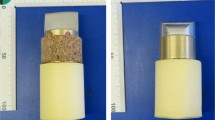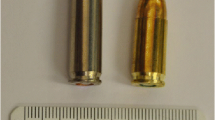Abstract
Background
In ballistic testing and forensic reconstruction, there is a need to use repeatable and consistent simulants. While synthetic bone is mechanically similar to human bone, it does not have the same viscoelastic properties. In high-energy impact such as ballistic impacts, bone acts as a stiff, brittle material and fails instantaneously. Therefore, a suitable simulant for use in ballistic testing should have comparable energy deposition to mammalian bones. This preliminary study aims to determine if Synbone® could be a viable proxy for Sus scrofa (domesticus) ribs in ballistic testing.
Methodology
Three thickness of Synbone® were embedded into 10% ballistic gelatin and shot using 5.56-mm ammunition. The models were then analysed to compare the Synbone® to a previous Sus scrofa (domesticus) rib study and focused on the number of fragments within the block, energy deposition, onset of yaw, angle of deviation, the temporary cavity as a percentage of the block and the depth to the temporary cavity centre, depth to maximum gelatin disruption and the permanent wound channel, including shear planes and wound tract diameter.
Results
There was no significant difference in the metrics that were compared between Sus scrofa (domesticus) ribs and the three thicknesses of Synbone®, except for a significant difference in the depth to maximum gelatin disruption between the 6 mm (p = 0.009) and 12 mm plate (p = 0.007) and the Sus scrofa (domesticus) ribs.
Conclusion
This study indicates that the 5-mm Synbone® plate is a suitable proxy for Sus scrofa (domesticus) ribs for use with 5.56-mm OTM ammunition in ballistic testing.





Similar content being viewed by others
Data availability
The datasets used and/or analysed during the current study are available from the corresponding author on reasonable request.
References
Mahoney P, Carr D, Arm R, Gibb I, Hunt N, Delaney RJ (2018) Ballistic impacts on an anatomically correct synthetic skull with a surrogate skin/soft tissue layer. Int J Legal Med 132(2):519–530
Bir C, Andrecovich C, DeMaio M, Dougherty PJ (2016) Evaluation of bone surrogates for indirect and direct ballistic fractures. Forensic Sci Int 261:1–7. https://doi.org/10.1016/j.forsciint.2016.01.023
Henwood BJ, Appleby-Thomas G (2020) The suitability of Synbone® as a tissue analogue in ballistic impacts. J Mater Sci 55(7):3022–3033. https://doi.org/10.1007/s10853-019-04231-y
Kieser DC, Carr DJ, Leclair SC, Horsfall I, Theis J-C, Swain MV, Kieser JA (2013) Remote ballistic fractures in a gelatine model-aetiology and surgical implications. J Orthop Surg Res 8(1):15
Kieser DC, Riddell R, Kieser JA, Theis J-C, Swain MV (2014) Bone micro-fracture observations from direct impact of slow velocity projectiles. J Arch Mil Med 2 (1)
Smith MJ, James S, Pover T, Ball N, Barnetson V, Foster B, Guy C, Rickman J, Walton V (2015) Fantastic plastic? Experimental evaluation of polyurethane bone substitutes as proxies for human bone in trauma simulations. Legal medicine (Tokyo, Japan) 17(5):427–435. https://doi.org/10.1016/j.legalmed.2015.06.007
Mahoney P, Carr D, Hunt N, Delaney RJ (2019) Assessment of polyurethane spheres as surrogates for military ballistic head injury. Int J Legal Med 133(1):163–167. https://doi.org/10.1007/s00414-018-1832-6
Tortora GJ, Derrickson B, Tortora GJ, Tortora GJ (2017) Tortora’s principles of anatomy & physiology
Abrahams PH, Spratt JD, Loukas M, Van Schoor A-N, Abrahams PH (2020) Abrahams’ and McMinn’s clinical atlas of human anatomy
Rho JY, Kuhn-Spearing L, Zioupos P (1998) Mechanical properties and the hierarchical structure of bone. Med Eng Phys 20(2):92–102. https://doi.org/10.1016/s1350-4533(98)00007-1
Synbone®. (2020). https://www.synbone.com/products/bone-models/. Accessed 17/05/2020 2020
Pullen A, Rodrigues S, Shaw B, Kieser DA (2017) Preliminary study in the variables of thoracic ballistic trauma. In: 30th International Symposium on Ballistics
Rodrigues SA, Guey J, Plummer T, Pullen A, Shaw B, Kieser D (2018) Influence of rib impact on thoracic gunshot trauma. J R Army Med Corps 164(6):405–409
Dahlstrom DB, Powley KD (1994) Comparative performance of 9 mm parabellum,. 38 Special and. 40 Smith and Wesson Ammunition in Ballistic Gelatin. Canadian Police Research Centre,
Dahlstrom DB, Powley KD, Kramer D (1995) Lead shot penetration in 10% ordnance gelatin. Canadian Police Research Centre–Technical report
Mabbott A, Carr D, Champion S, Malbon C (2016) Comparison of porcine thorax to gelatine blocks for wound ballistics studies. Int J Legal Med 130(5):1353–1362
Mabbott A (2015) The overmatching of UK police body Armour. Cranfield University
Kieser JA, Tahere J, Agnew C, Kieser DC, Duncan W, Swain MV, Reeves MT (2011) Morphoscopic analysis of experimentally produced bony wounds from low-velocity ballistic impact. Forensic Sci Med Pathol 7(4):322–332. https://doi.org/10.1007/s12024-011-9240-y
Caister AJ, Carr DJ, Campbell PD, Brock F, Breeze J (2020) The ballistic performance of bone when impacted by fragments. Int J Legal Med 134:1387–1393. https://doi.org/10.1007/s00414-020-02299-9
Carr D, Kieser J, Mabbott A, Mott C, Champion S, Girvan E (2014) Damage to apparel layers and underlying tissue due to hand-gun bullets. Int J Legal Med 128(1):83–93. https://doi.org/10.1007/s00414-013-0856-1
Fragkouli K, Al Hakeem E, Bulut O, Simmons T (2018) The effect of range and ammunition type on fracture patterns in porcine postcranial flat bones. J Forensic Legal Med 53:1–12. https://doi.org/10.1016/j.jflm.2017.10.004
Breeze J, Hunt N, Gibb I, James G, Hepper A, Clasper J (2013) Experimental penetration of fragment simulating projectiles into porcine tissues compared with simulants. J Forensic Legal Med 20(4):296–299. https://doi.org/10.1016/j.jflm.2012.12.007
DTA (2019) Technical instructions: manufacture of ballistic gelatin. Defence Technology Agency,
Guey J, Rodrigues S, Pullen A, Shaw B, Kieser D (2018) Effect of ageing on the calibration of ballistic gelatin. J R Army Med Corps 164(4):277–280
Maiden NR, Fisk W, Wachsberger C, Byard RW (2015) Ballistics ordnance gelatine–how different concentrations, temperatures and curing times affect calibration results. J Forensic Legal Med 34:145–150
Pullen A, Kieser DC, Hooper G (2020) Ballistic gelatin calibration standardisation. BMJ military health:bmjmilitary-2020-001430. doi:https://doi.org/10.1136/bmjmilitary-2020-001430
Ruchonnet A, Diehl M, Tang Y-H, Kranioti EF (2019) Cranial blunt force trauma in relation to the victim’s position: an experimental study using polyurethane bone spheres. Forensic Sci Int 301:350–357. https://doi.org/10.1016/j.forsciint.2019.05.051
Acknowledgements
The authors would like to acknowledge Dylan Allison (NZDF) for assistance with model preparation and trials support. We are also grateful to Angus Newton for use and assistance of ESR’s ballistic range and, finally, Glynny Kieser for her editorial input.
Funding
The project was funded by the New Zealand Defence Force.
Author information
Authors and Affiliations
Contributions
Amy Pullen developed concept and methodology, carried out the trials and analysis. David Kieser and Gary Hooper supervised the work, verified the analytical methods, reviewed the results. The first draft of the manuscript was written by Amy Pullen and all authors commented on previous versions of the manuscript. All authors read and approved the final manuscript.
Corresponding author
Ethics declarations
Conflict of interest
The authors declare that they have no conflict of interest.
Ethical approval
Ethical approval was not needed, and no human or animal subjects were involved. Ballistic gelatin is commercially available.
Informed consent
Not applicable.
Code availability
Not applicable.
Additional information
Publisher’s note
Springer Nature remains neutral with regard to jurisdictional claims in published maps and institutional affiliations.
Rights and permissions
About this article
Cite this article
Pullen, A., Kieser, D.C. & Hooper, G. A study into the viability of Synbone® as a proxy for Sus scrofa (domesticus) ribs for use with 5.56-mm open tip match ammunition in ballistic testing. Int J Legal Med 135, 521–526 (2021). https://doi.org/10.1007/s00414-020-02416-8
Received:
Accepted:
Published:
Issue Date:
DOI: https://doi.org/10.1007/s00414-020-02416-8




